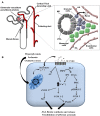The succinate receptor as a novel therapeutic target for oxidative and metabolic stress-related conditions
- PMID: 22649411
- PMCID: PMC3355999
- DOI: 10.3389/fendo.2012.00022
The succinate receptor as a novel therapeutic target for oxidative and metabolic stress-related conditions
Abstract
The succinate receptor (also known as GPR91) is a G protein-coupled receptor that is closely related to the family of P2Y purinoreceptors. It is expressed in a variety of tissues, including blood cells, adipose tissue, the liver, retina, and kidney. In these tissues, this receptor and its ligand succinate have recently emerged as novel mediators in local stress situations, including ischemia, hypoxia, toxicity, and hyperglycemia. Amongst others, the succinate receptor is involved in recruitment of immune cells to transplanted tissues. Moreover, it was shown to play a key role in the development of diabetic retinopathy. However, most prominently, the role of locally increased succinate levels and succinate receptor activation in the kidney, stimulating the systemic and local renin-angiotensin system, starts to unfold: the succinate receptor is a key mediator in the development of hypertension and possibly fibrosis in diabetes mellitus and metabolic syndrome. This makes the succinate receptor a promising drug target to counteract or prevent cardiovascular and fibrotic defects in these expanding disorders. Recent development of SUCNR1-specific antagonists opens novel possibilities for research in models for these disorders and may eventually provide novel opportunities for the treatment of patients.
Keywords: GPCR; GPR91; SUCNR1; diabetes mellitus; oxidative stress; renal disease; rennin; succinate.
Figures




References
-
- Aguiar C. J., Andrade V. L., Gomes E. R., Alves M. N., Ladeira M. S., Pinheiro A. C., Gomes D. A., Almeida A. P., Goes A. M., Resende R. R., Guatimosim S., Leite M. F. (2010). Succinate modulates Ca(2+) transient and cardiomyocyte viability through PKA-dependent pathway. Cell Calcium 47, 37–4610.1016/j.ceca.2009.11.003 - DOI - PubMed
-
- Bhuniya D., Umrani D., Dave B., Salunke D., Kukreja G., Gundu J., Naykodi M., Shaikh N. S., Shitole P., Kurhade S., De S., Majumdar S., Reddy S. B., Tambe S., Shejul Y., Chugh A., Palle V. P., Mookhtiar K. A., Cully D., Vacca J., Chakravarty P. K., Nargund R. P., Wright S. D., Graziano M. P., Singh S. B., Roy S., Cai T. Q. (2011). Discovery of a potent and selective small molecule hGPR91 antagonist. Bioorg. Med. Chem. Lett. 21, 3596–360210.1016/j.bmcl.2011.04.091 - DOI - PubMed
LinkOut - more resources
Full Text Sources
Other Literature Sources
Molecular Biology Databases

